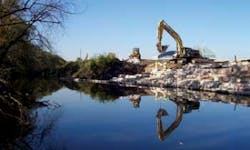Integrating, Innovating & Collaborating: A Holistic Approach to Urban Water Management
By Ben Grumbles
"One Water" – it's the new mantra for urban water leaders. States and municipalities are realizing the interconnectedness among land management, agriculture, manufacturing, and water quality. On the quantity side, fragile supplies are providing teachable moments for the connections between all types of water (drinking, waste, storm, gray, produced, recycled) and water-intensive energy. Urban water leaders are embracing a more holistic approach, including use of non-traditional "green infrastructure" strategies. A paradigm shift is occurring.
Sitting at the cutting edge of these methods are two leaders in particular. The City of LA (particularly the Bureau of Sanitation), and NYC's Department of Environmental Protection, have comprehensive plans briefly described below. They are among five winners being recognized with the 2011 U.S. Water Prize. All have in common implementation or promotion of Integrated Water Resource Management. All are trailblazers with innovations that create models for others. Most importantly, they are the collaborators, those who open the doors, welcome new partners, and raise public awareness.
Los Angeles
The city's Water Integrated Resources Plan (IRP) started in the late 90s with a simple yet ambitious vision: city departments working with the community to manage water resources holistically. Key to its success, the plan incorporates the values of Los Angeles communities into infrastructure planning and integrates three interdependent water systems: wastewater, recycled water and stormwater. More than 100 community leaders joined the city in planning the future of wastewater, recycled water and urban runoff management in Los Angeles. By realizing the relationships among these water resources and planning on a watershed basis, the community and the environment get the highest benefit for the least overall cost.
Rainwater harvesting was foundational, identifying local solutions as pillars for sustainability – resulting in a downspout program that will be expanded citywide.
Transforming the city's water footprint is the Elmer Avenue green street project that includes an infiltration gallery that captures runoff and recharges it underground. Neighbors embrace the bioswales with drought-tolerant native plants and permeable surfaces that adorn this appealing greenspace.
The South Los Angeles Wetlands Park will convert an asphalt/concrete rail yard into a 4.5-acre stormwater treatment wetland habitat that captures and treats pollutants and also will include a pocket park – another win-win for the community.
The IRP also produced a far-reaching Low Impact Development ordinance and a 20% reduction in water use due to conservation incentives and education. Los Angeles' water consumption today is the same as it was 30 years ago despite one million more users. As implementation continues, the city keeps stakeholders engaged and involved – putting Los Angeles on the path to becoming one of the greenest and cleanest 'big cities' in America while ensuring a waterwise and sustainable future.
NYC Department of Environmental Protection (DEP)
New York remains one of only five large cities in the country not required, under the Safe Drinking Water Act, to filter the majority of its drinking water because of upstream source water protection safeguards in place. By focusing on protecting the watershed rather than treating water polluted by the effects of varied land use, DEP has accomplished many sustainability goals. To protect its source water, NYC has conserved more than 115,000 acres of watershed land. The city monitors farmers on its land to ensure agricultural practices are compatible with water quality protection and has assisted upstream homeowners in replacing their failing septic systems.
The NYC Green Infrastructure Plan, released by Mayor Bloomberg in September 2010, plans for $1.5 billion in investments in green infrastructure over the next 20 years, on top of $2.9 billion in built or planned gray infrastructure. The Green Infrastructure Plan lays out how the city will improve harbor water quality by capturing and retaining stormwater runoff before it enters the sewer system by using streetside swales, tree pits, and rooftop detention to absorb and retain stormwater. The hybrid approach will reduce combined sewer overflows by 12 billion gallons a year – more than 2 billion gallons a year more than the current all-gray strategy while saving New Yorkers $2.4 billion. The plan has been submitted and is awaiting approval by the State Department of Environmental Conservation.
NYC DEP has also announced a comprehensive energy strategy with three main goals consistent with broader city initiatives: (1) to reduce the carbon footprint, including emissions of greenhouse gases and criteria pollutants consistent with the goals set out in PlaNYC; (2) to reduce electricity demand, the cost of which is expected to almost double from $69.7 million in 2009 to approximately $132 million by 2014 in the absence of aggressive energy efficiency investments; and (3) to explore clean energy projects.
In an effort to provide better water management tools to the customer, DEP has installed over 600,000 Automated Meter Reading (AMR) devices that allow customers to check their water usage a minimum of four times per day. By January 2012, all of the city's 835,000 customers will have AMR installed. DEP is committed to using the AMR system to develop a proactive notification system for customers. With new real-time consumption data available through AMR, DEP will develop a notification program to let property-owners know when their water consumption appears to deviate from normal usage.
U.S. Water Prize
As we work toward the "One Water" paradigm, models such as the City of LA and NYC DEP become essential to spreading innovation and generating better management practices. As part of its mission, the Clean Water America Alliance is celebrating and promoting these leaders through the annual U.S. Water Prize. The inaugural awards ceremony will be held in May and will recognize five outstanding leaders: the two you've just read about, as well as the Milwaukee Water Council, National Great Rivers Research and Education Center, and the Pacific Institute. Visit the Alliance's website, www.CWAA.us, to learn more about the award-winning water champions.
WW
About the Author: Ben Grumbles is President of the Clean Water America Alliance, a not-for-profit educational organization based in Washington, DC and committed to uniting people and policies for water sustainability throughout the country. Most recently, he led Arizona's Department of Environmental Quality and formerly served as Assistant Administrator for Water at US EPA.
More WaterWorld Current Issue Articles
More WaterWorld Archives Issue Articles


